Nuclear Magnetic Resonance (NMR) spectroscopy is a widely used analytical technique in chemistry for exploring chemical composition. NMR spectroscopy provides details about the kinetics and structure of substances, allowing the study of unstable reaction species in situ. Recent advancements in high-power fiber-coupled light-emitting diodes (LEDs) have enabled researchers to integrate these fiber-coupled LEDs with NMR spectroscopy for various applications, especially in the photochemistry field.
The Fiber-Coupled LEDs can also substitute lasers in Photochemically induced dynamic nuclear polarization (photo-CIDNP) applications. Photo-CIDNP is a technique that utilizes light to significantly enhance the NMR signal. The light excited molecules can undergo chemical reactions leading to short-lived radical pairs. The interaction between the nuclear spins of the radical pair and their unpaired electrons creates a non-equilibrium distribution of spin states (hyperpolarization). When the hyperpolarized molecules return to their ground state, they release excess energy, causing a significant increase in the NMR signal. This enhancement of NMR sensitivity makes Photo-CIDNP a powerful tool for studying molecules at very low concentrations, such as aromatic amino acids and proteins. The photo-CIDNP enables the study of short-lived radicals and other transient species that are involved in chemical reactions for this purpose the fast TTL input (few usec Rise/Fall Time) of Fiber-Coupled LEDs is very useful to trigger the light at correct timing.
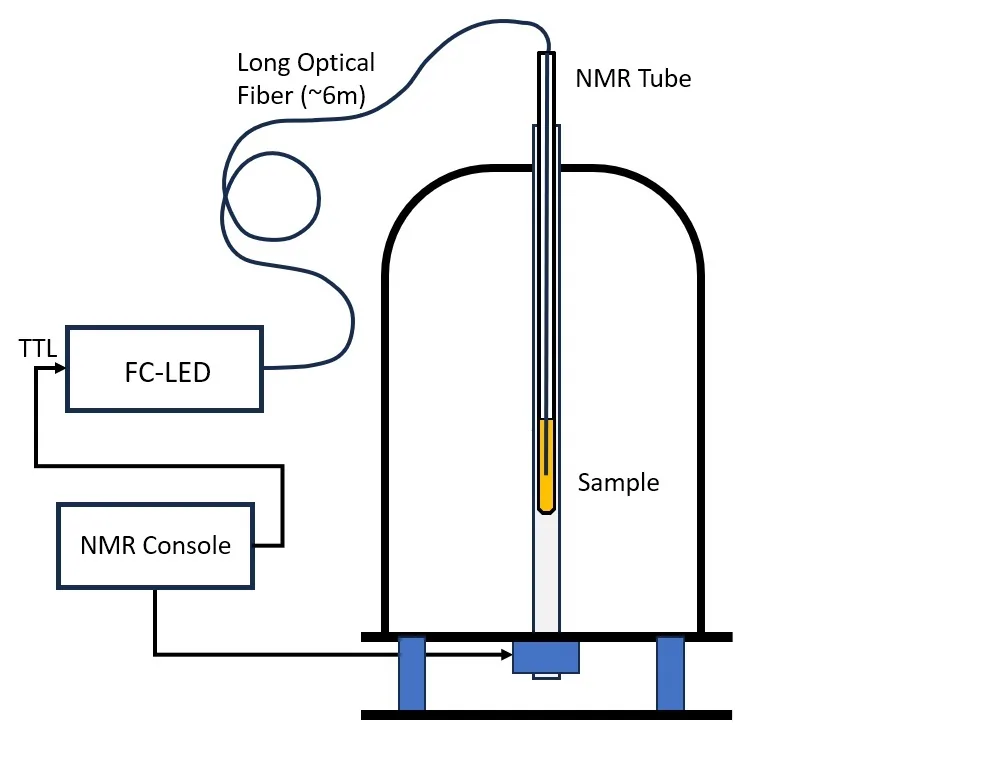
A typical LED for an NMR illumination system comprises FC-LED connected to a long (~4m) optical fiber. At the distal end, the fiber is inserted into the NMR tube and submerged into the sample. The fiber may be inserted into a coaxial insert tube to provide additional protection for the fiber.
Optical Fibers for NMR-LED Spectroscopy
To achieve good illumination of the whole sample the distal end of the fiber is stripped from the opaque Jacket (see below for Polymer Optical Fiber Anatomyy) and the Cladding is sanded to create a rough surface to cause the light to escape the fiber along this surface and not only at the tip (See Figure 2).
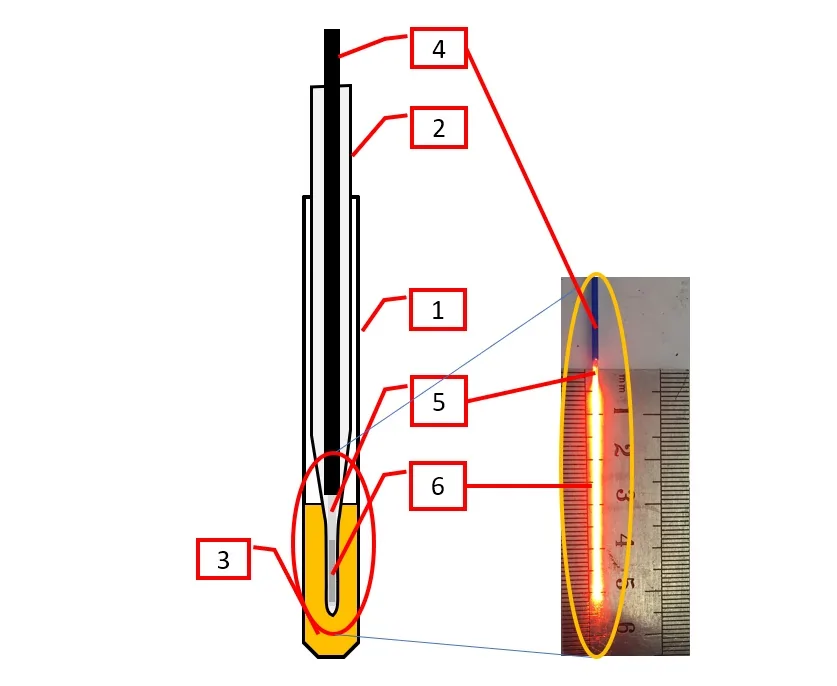
[1] NMR Tube, [2] Coaxial insert tube, [3] Sample, [4] Optical Jacketed fiber, [5] Stripped (Unjacketed) Fiber, [6] Sanded fiber for peripheral illumination.
There are many various types of optical fibers. For the application of LEDs with NMR the best fibers are large core diameter (~1000um) high NA (>0.39) fibers. These fibers accept and transmit a significant part of the light emitted by the LED. Particularly Polymer Optcal-Fibers (POF) with a core diameter of 1000 µm and NA=0.5 were identified as suitable for LED-NMR applications.
These fibers demonstrate efficient coupling with LEDs, good optical transmission, and high flexibility for easy installation. Moreover, they exhibit high durability and are resistant to breakage. The Polymer fibers are compatible with sanding and are cost-effective. The POF fibers have a relatively very thin Cladding that enables effective sanding with good homogeneity of light distribution along the sanded part of the fiber.
An alternative fiber choice suitable for LED-NMR applications is the silica core polymer-clad fibers. With a core diameter of 1000um and high numerical apertures (NA=0.5), these fibers provide versatility, although they may be less flexible than POF and could occasionally experience cracking. Despite these drawbacks, silica core polymer-clad fibers offer transmission at short UV wavelengths (<350nm) and at Near IR (>750nm), providing a wavelength range not supported by POF fibers.
Polymer Optical Fiber Anatomy: the transparent Core is the PMMA media where light is transmitted along the fiber. The Cladding is a very thin (a few micrometers) layer surrounding the core. Rays imping the core-cladding interface at an angle greater than the critical angle are reflected to the core. The Jacket layer is an opaque, thick polymer layer protecting the core and the cladding from mechanical damage. Light entering the core at the proximal end (e.g. at FC-LED) will go out mainly at the distal end of the fiber. The cone of light emitted from the fiber has a specific angle α. This is an important fiber parameter as it also defines the acceptance angle of the light that can be coupled to the fiber. Commonly it is specified as Numerical Aperture, NA=sin(α), rather than actual angle Alpha (n denotes the refraction coefficient of the core material). As a rule of thumb, higher NA enables more LED light to be coupled to the fiber.
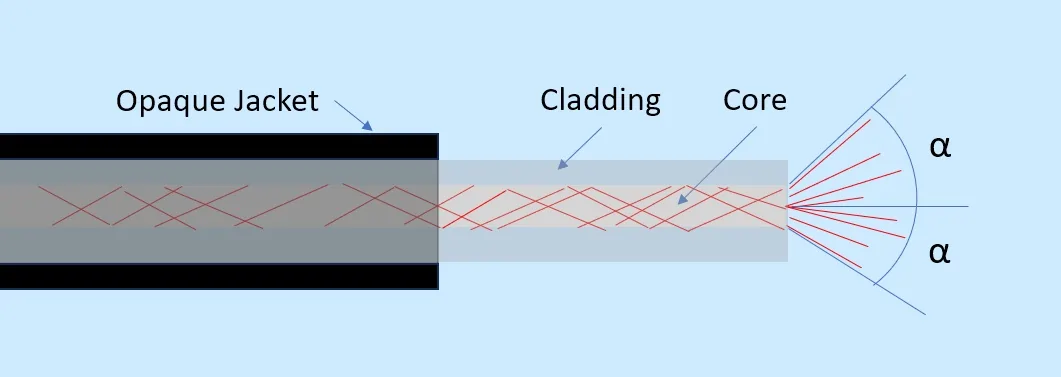
Prizmatix offers polymer fibers for NMR applications:
The most popular NMR fiber is:
| P/N | Description |
| NMR-Fiber-1000 | High NA Polymer Optical Fiber (POF) Core: 1000um NA: 0.5. SMA Connector. End tip specially processed for NMR tubes: 7cm stripped, 5cm sanded for radial illumination. Standard Length 6m. |
Light sources for LED-NMR / photo-CIDNP applications
The Fiber-Coupled LED is designed to maximize the coupling efficiency of the LED light into the fiber. The LED light can be synchronized with NMR spectrometer via TTL input. The level of light power can be controlled manually or from the computer via Analog Input or USB.
Light sources for LED-NMR / photo-CIDNP applications
Prizmatix has a vast offering of Fiber-Coupled LEDs that can be useful for NMR applications.
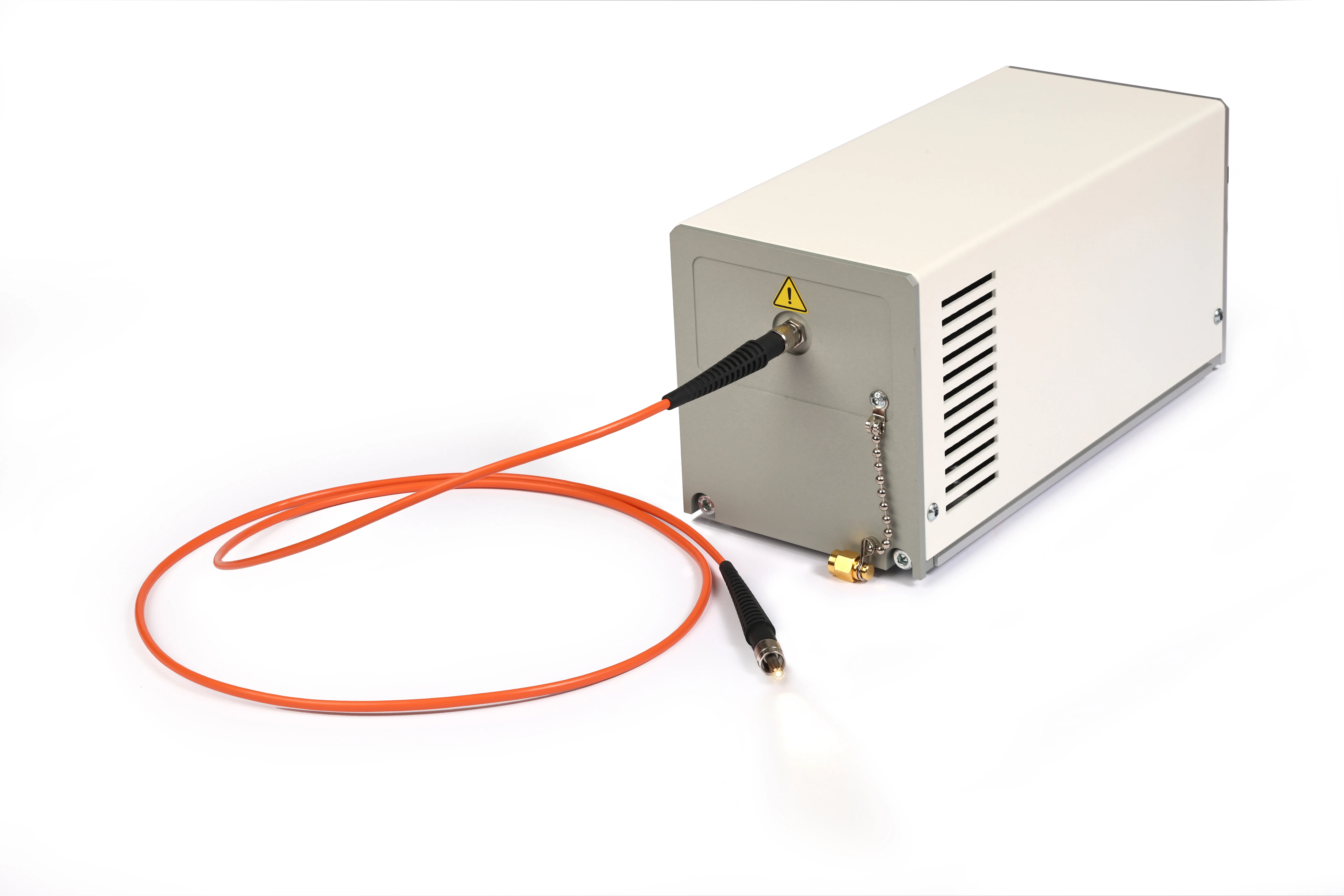
|
The UHP-LED-FB product line incorporates the highest brightness and power LED chips suitable for more demanding power requirements. |
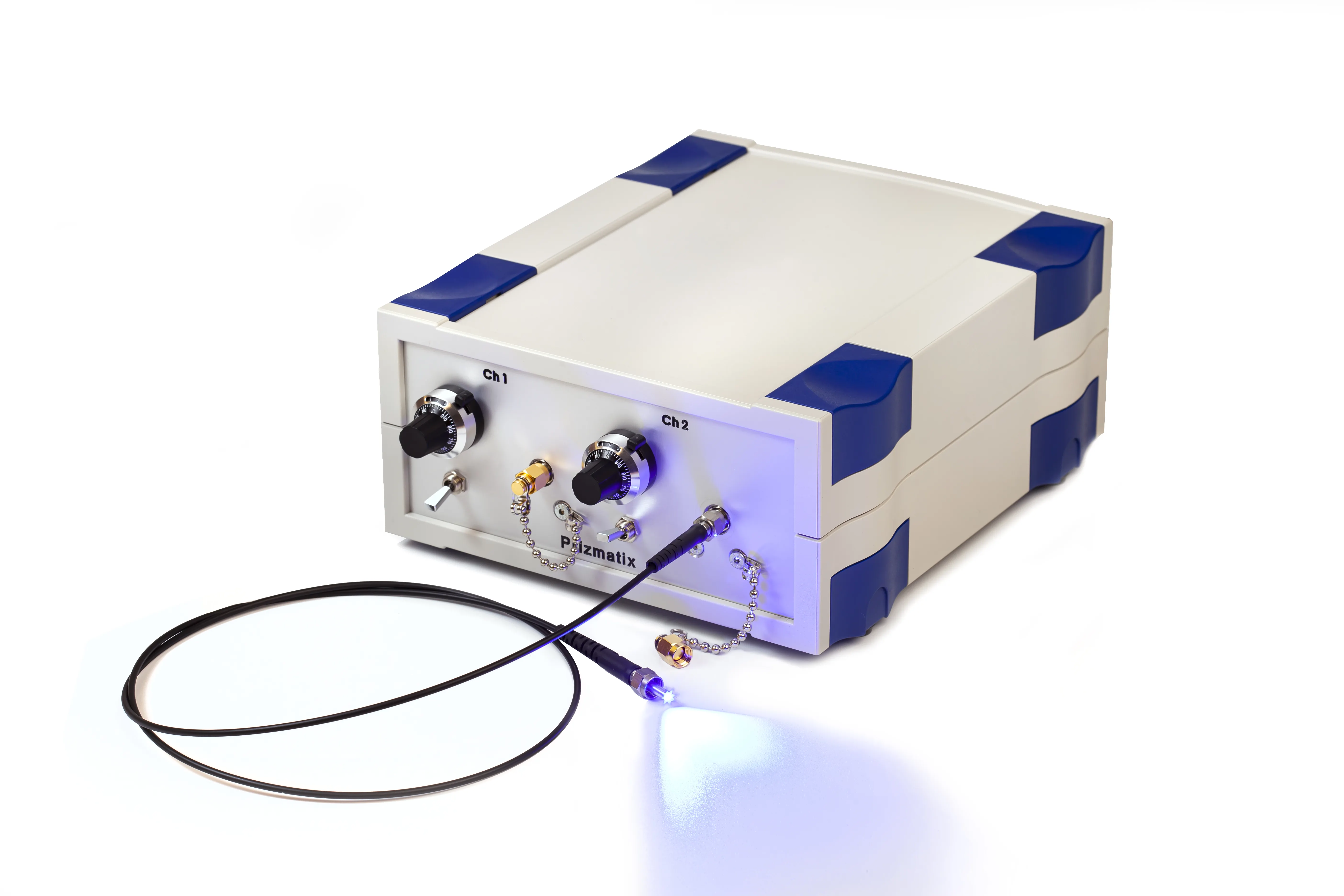
|
The FC-LED product line includes single-channel or multi-channel (up to 10 various LEDs in a single enclosure) fiber-coupled high-power LED products. |
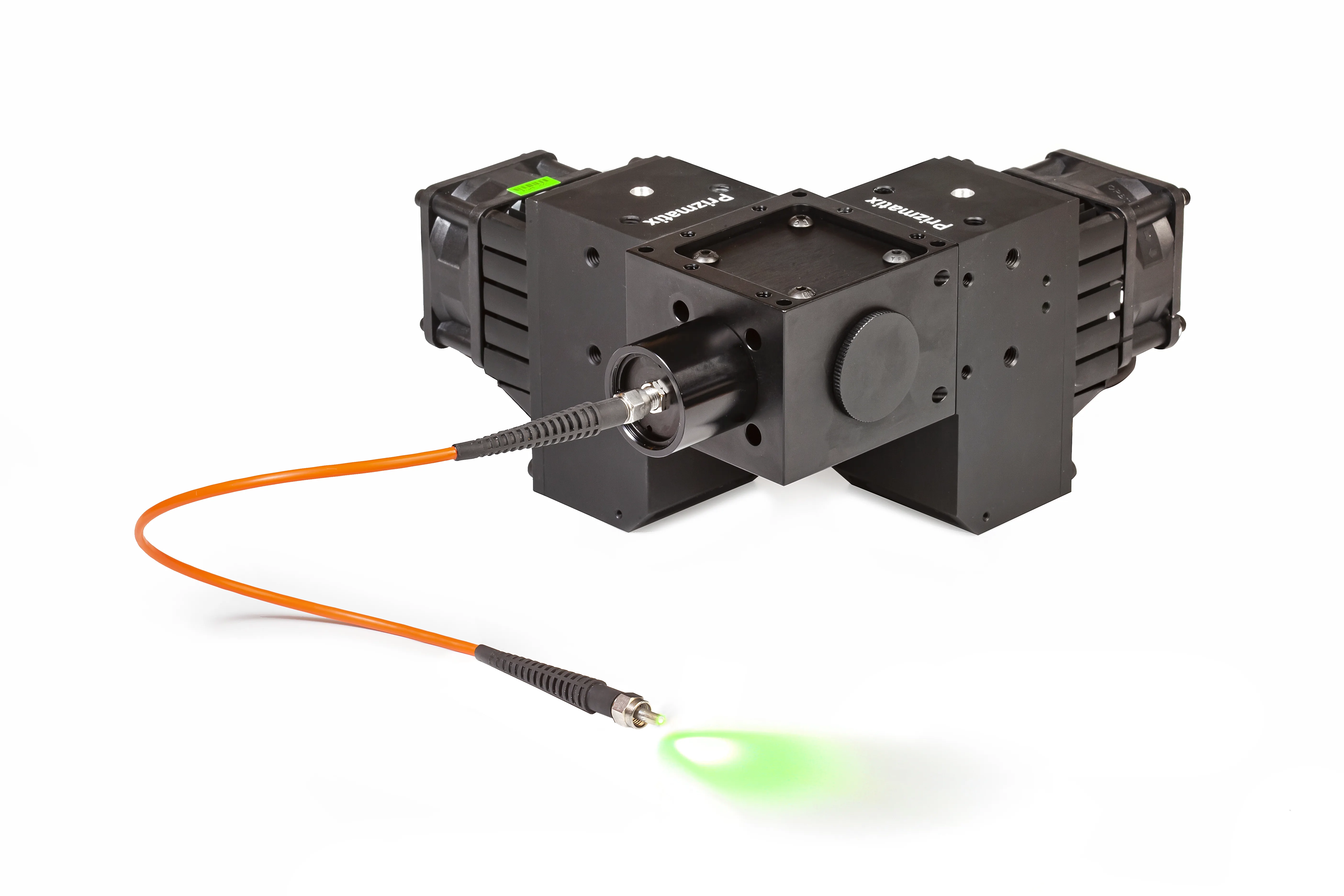
|
The UHP-T-LED product line facilitates the incorporation of a bandpass filter between the LED and the fiber. This becomes crucial when a specific activation wavelength bandpass is required. Moreover, UHP-T-LEDs are valuable for assembling dual-wavelength or triple-wavelength light sources. |
Questions and Answers
1 Q.: How do Prizmatix LEDs compare to traditional lasers in terms of performance for applications like photo-CIDNP NMR?
1 A.: Prizmatix LEDs offer several advantages over traditional lasers for photo-CIDNP NMR applications:
Cost and Maintenance: LEDs are significantly more cost-effective than high-power lasers. They also require less maintenance, as they don't have the delicate components or complex cooling systems found in lasers.
Ease of Use: LEDs are easier to integrate into your existing setup. They don't require the complex alignment procedures and cooling systems that lasers often need, making them more user-friendly.
Versatility: Prizmatix offers a wide range of LED wavelengths, allowing you to precisely match the light source to your specific experiment. Additionally, our light sources work with various optical fibers and configurations, providing flexibility for diverse experimental needs.
Safety: LEDs are generally safer to use than lasers. They emit less intense light, reducing the risk of accidental exposure and the need for stringent safety protocols.
Performance: While traditional lasers offer highly coherent and intense light, Prizmatix LEDs can achieve comparable performance in terms of light delivery and efficiency, particularly when paired with appropriate optical fibers.
Triggering and Control: Prizmatix LEDs feature fast TTL inputs for precise timing control, crucial for synchronized experiments. Power control can be achieved via a manual dial, Analog input, or USB for seamless integration with your existing setup.
Overall, Prizmatix LED light sources provide a practical and efficient alternative to traditional lasers for photo-CIDNP NMR. They offer significant advantages in terms of cost, ease of use, versatility, safety, and precise control.
2 Q.: What are the suitable light sources for NMR spectroscopy experiments where the illumination source must be located at a significant distance from the spectrometer (e.g., due to strong magnetic fields)?
2 A.: The most suitable light source will depend on several factors, including:
Required Wavelengths: The specific NMR experiment will dictate the necessary illumination wavelengths (e.g., UV, visible, near-infrared).
Illumination Intensity: Long fiber optic cables can introduce significant light attenuation. Therefore, the light source must have sufficient output power to deliver adequate illumination at the sample.
NMR Spectrometer Control Interfaces: To fulfill requirements such as synchronization between the NMR spectrometer and the light source On/Off state, as well as the ability to control the light intensity, the NMR control unit needs to be connected to the light source by appropriate electronic interfaces. The light source shall include control options such as TTL input, analog input for power setting, or USB control.
A suitable option for many remote illumination scenarios is the UHP-FB-LED fiber-coupled light source. Key Advantages of UHP-FB-LEDs:
High Power Output: These LEDs are designed to provide sufficient power to overcome significant optical losses in long fiber optic cables..
Broad Wavelength Range: UHP-FB-LEDs are available in a wide range of wavelengths, covering the UV, visible, and near-infrared regions..
TTL On/Off Control: Featuring standard TTL On/Off control for seamless integration with NMR control units..
Analog Input 0-5V Signal: Allows for external control of power levels using an analog signal, providing flexibility for integration with other systems..
Power Control: The UHP-FB-LED offers versatile power control options:
- With Display: Precise power level adjustment with visual feedback.
- Without Display: Simple and direct control for basic power adjustments.
3 Q.: Where I can find more information on Light-Assisted NMR?
References:
Hanming Yang, Heike Hofstetter, Silvia Cavagnero; Fast-pulsing LED-enhanced NMR: A convenient and inexpensive approach to increase NMR sensitivity. J. Chem. Phys. 28 December 2019; 151 (24): 245102. https://doi.org/10.1063/1.5131452
James P. Yesinowski, Joel B. Miller, Christopher A. Klug, Holly L. Ricks-Laskoski, Optorelaxers: Achieving real-time control of NMR relaxation, Solid State Nuclear Magnetic Resonance, Volume 96, 2018, Pages 1-9, ISSN 0926-2040, https://doi.org/10.1016/j.ssnmr.2018.09.002
© |

